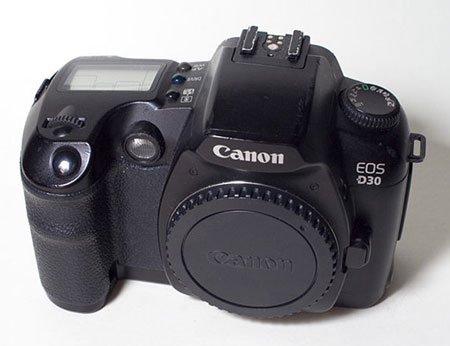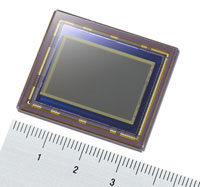The Digital Sensor: A Guide to Understanding Digital Cameras
by Wesley Fink on April 21, 2008 1:00 AM EST- Posted in
- Digital Camera
CCD and CMOS
At the dawn of the digital SLR era, almost every sensor was a CCD (Charge Coupled Device). CCDs were relatively easy to make, but they were and remain basically a single function sensor. CCD sensors create very high image quality and low noise, but they require support circuitry for almost every function provided by the CCD. The CMOS (Complementary Metal Oxide Semiconductor) sensor was always a possible alternative in sensor design, but manufacturing CMOS sensors was very difficult with the technology available at that time. CMOS sensors are inherently lower image quality and higher noise than CCD, which led some experts to predict that a production CMOS sensor for DSLR imaging would never be made.
There are many reasons manufacturers would have preferred the alternative of the CMOS sensor. While difficult to manufacture they are much cheaper to make in volume than CCD sensors. Power consumption for CMOS is inherently lower than the CCD sensor. In addition, the CMOS sensor lends itself to integrating other electronics, such as the analog to digital conversion and noise reduction electronics into the sensor itself - something not really possible with the CCD design.

Those who did not think a commercial CMOS sensor was possible were silenced with the introduction of the $3000 Canon D30 in the fall of 2000. Canon has championed the CMOS sensor, almost exclusively, since that time. However, in the past year other sensor manufacturers have been able to produce their own CMOS sensors. As a result, almost every new sensor introduction in recent months has been CMOS.

In fact, Sony was the first to market with a 12MP+ APS C size CMOS sensor, used in the Nikon D300 and Sony A700. This was followed in about 6 months by the introduction of the Samsung 14.6MP APS-C CMOS sensor in the Pentax K20D. It appears other sensor makers who previously trailed Canon in CMOS development are now the ones pushing the envelope in CMOS sensor development. Sony has also announced a 24.81 effective megapixel CMOS sensor that will be used in a full-frame Sony later this year that will likely be called the A900. The Sony and Samsung thrust into CMOS sensors makes more sense when you realize that Sony and Samsung jointly own several recent patents in CMOS technology. Panasonic is also producing CMOS sensors as seen in their LiveMOS sensors used in the Olympus E-3 and E-501/410/420.

LEFT: Conventional Image CMOS Image Sensor Circuit Structure
RIGHT: Column-Parallel A/D Converter CMOS Image Sensor Circuit Structure
Sony has also taken advantage of another CMOS capability by combining analog to digital conversion and image noise reduction on the CMOS sensor itself in the 12.2MP A700. Some photo review sites had apoplectic fits when they realized Sony was doing noise reduction on the A700 chip, but this is an inevitable development. This move to larger integration of electronics into the CMOS sensor module is just starting, and it could eventually lead to a much larger scale integration of digital image processing functions into the sensor chip - or even a camera on a chip.










72 Comments
View All Comments
Johnmcl7 - Monday, April 21, 2008 - link
I do agree with you there that it is desirable to have deeper depth of field (particularly on macro) but I think the difference is that on an SLR you have the choice - you can shoot wide open and have shallow depth of field or you can stop down (and normally have to use up the ISO advantage) to get depth of field. On a camera with a small sensor you are generally stuck with the deep depth of field whether you want it or not.John
finbarqs - Monday, April 21, 2008 - link
I hope nobody is using F/1.2 when shooting a portrait. Unless you want only a nose to be in focus. With something THAT shallow, you either have to REALLY step back and use distance to your advantage to get what you want in Focus. Professional Wedding photographers will not TOUCH anything above f/5.6 as you don't want to get ONLY the bride in focus while the groom is OOF.People, remember there are multiple factors that affect DOF. Aperture is definitely one of them, distance, and Focal Length.
Obviously you want something very shallow with great bokeh, then you would get close to your subject, open up your aperture, and have a telephoto focal length.
The thing is, on a FF sensor, you "see more" on the same focal length as a cropped sensor. Well put wesley, a 50mm is a 50mm. For those of us with cropped sensors, slap a 50mm on your camera. (or zoom to 50mm). Look at your subject with your naked eye, then look through the view finder. SAME SIZE AND SHAPE! Nothing gets larger! Supposedly a telephoto range (greater than normal) should have some zoom effets shouldn't it? I mean APS-C sensors are either 1.5 or 1.6 smaller than a full frame, that means the normal focal length should be around 27mm? So 50mm should be 75mm for nikons and 80mm for canons! That means you should see some zoom in 50mm! but nope! you don't! in fact, the only time you'll see the zoom is AFTER you fire the shutter and it displays the image to fill that 2.5" or 3.0" inch lcd you have! (or even 2.0") So where does the FF excel? you place 2 cameras exactly side by side of each other, same focal length, same focus point. Same lens. Through the Viewfinder, you'll see the nice Bokeh of your subject on BOTH cameras, exactly the same. Difference? the FF has more frame coverage! Thus, having better "DOF" (or lack thereof) because of the more frame coverage! On this note, let's all by Hasselblad's Medium FF and get some nice digital backs! ;)
haplo602 - Tuesday, April 22, 2008 - link
Hmm ... In my understanding the difference in FF to APS-C is CROP.A 50mm lens on APS-C has the same DOF, same perspective characteristic as on a FF camera, but the sensor is smaller, so you basicaly get a CROP of the original FF image. There is only a perceived zoom effect as the image is a smaller area.
For Nikon you get 1.5x smaller image area, but everything else is the same as on FF.
melgross - Tuesday, April 22, 2008 - link
It has to do with distance from the subject as well. Perspective is the ratio of the distance to the subject to the distance to the background.So, to get the same size on sensor, with the same lens length, you must either move closer, or further, changing the perspective, and the depth of field.
finbarqs - Monday, April 21, 2008 - link
Medium Format* sorry, typo :)Johnmcl7 - Monday, April 21, 2008 - link
Other way round - a larger sensor gives you *less* depth of field which as you quite rightly point out is a strong advantage of a larger sensor.John
pinto4402 - Monday, April 21, 2008 - link
DOF is also a function of the lens. Some ultra-serious photographers are willing to pay $2500 for a Canon 85mm 1.2L over a 85mm 1.8 (which is just as sharp and which only retails for $300), because the 1.2L has a softer, more pleasing DOF effect.TETRONG - Monday, April 21, 2008 - link
Cool article.Looking to buy a camera pretty soon here.
What do you folks think about the G9?
Is there a particular brand I should favor?
Also, are there any cameras available that do "tricky" stuff, like Infrared, Macro, or that neat effect when cities look miniature? (Can't find an example)
I read an article about a guy a few years back that would setup a scene, then he would walk around selectively lighting certain aspects in trippy ways to make a final composite image.
Anyone know what this is called, or where I can learn more about it?
Much obliged!
strikeback03 - Tuesday, April 22, 2008 - link
Is "fisheye" what you are looking for for the miniature cities?and the selective lighting is often called "Painting with light"
plenty of compact cameras can do OK macro if you can get really close to your subject, but as this is often hard for reasons of lighting and/or scaring off the subject, an SLR with a real macro lens is still beneficial.
pinto4402 - Monday, April 21, 2008 - link
There was an article at http://www.popphoto.com/popularphotographyfeatures...">http://www.popphoto.com/popularphotogra.../4923/th...about infrared photography. It also discusses a company that is modifying certain digital cameras for infrared use.